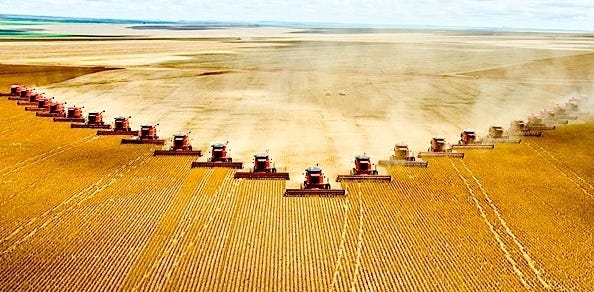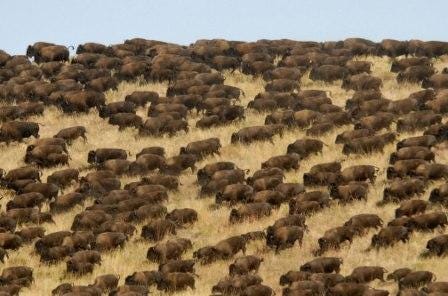Ed. note: This piece is taken from Courtney’s new weekly newsletter. If you would like to subscribe, please go here.
Welcome to Terra Firma by Courtney White. I’ve spent my life prospecting for innovative, practical, and collaborative answers to pressing problems involving land and people, sharing them with others. I’d like to share them with you!
I’ve been involved with save-the-world work for over thirty years (yikes!) and I can say unequivocally that one of the most hopeful, truly amazing stories I’ve ever come across is regenerative agriculture. It is also one the least widely known, especially to anyone who isn’t involved with food production – which is nearly everyone!
I thought this important topic would be a great way to launch this newsletter.
 First, a quick definition (by yours truly): Regenerative Agriculture is both an attitude and a suite of practices that restores soil health and fertility, expands biodiversity, protects watersheds, and improves resilience in nature and ourselves. It focuses on creating the conditions for life, especially in the soil, and takes its cues from nature which has a very, very long track record of successfully growing things.
First, a quick definition (by yours truly): Regenerative Agriculture is both an attitude and a suite of practices that restores soil health and fertility, expands biodiversity, protects watersheds, and improves resilience in nature and ourselves. It focuses on creating the conditions for life, especially in the soil, and takes its cues from nature which has a very, very long track record of successfully growing things.
Resilience, by the way, is a 64-cent word for ‘bouncing back’ after a shock or disturbance, such as a forest fire. This will be increasingly critical to the world. Oh! I should also mention that regenerative agriculture fights global warming.
If this sounds like regenerative agriculture has Super Powers – that’s because it does! It has the ability to grow healthy food and repair damaged land using special powers supplied by sunlight, carbon dioxide, water, minerals, and an army of tiny super heroes: soil microbes. It’s an unstoppable force in a righteous cause.
Don’t take my word for it. Before his death last year, Stan Lee, the legendary founder of Marvel Comics and creator of Iron Man and Spider Man, was working on a new super hero character called DirtMan. I kid you not! (see)
Unlike industrial farming, regenerative agriculture can do all these things because it is anchored in biology, not chemistry, and utilizes natural processes to achieve its goals. The carbon cycle, for instance, by which energy from the sun makes its way to a plant’s roots as carbon (thanks to the miracle of photosynthesis) to be bartered with soil microbes for essential nutrients has been going on for 500 million years.
In contrast, in only 150 years we have badly damaged our land and our health with agricultural practices that have poisoned, plowed, eroded, and desiccated nearly every acre. Call it degenerative agriculture (see). I’m not going to throw a bunch of stats at you in my newsletters, so I’ll just say take a look at a report the IPCC published in August 2019 titled Climate Change and Land (see). But have a stiff drink ready!
Regeneration is the foundation of hope, in my opinion, and it extends well beyond agriculture. That’s because life is a force that can’t be denied, not if we give it a chance. If there’s one thing I’ve learned in my career it is this: nature still has the best ideas. This will be a major theme of Terra Firma.
Unfortunately, we humans think we’re smarter than nature and now we’re paying a big price. The ancient Greeks called it hubris – here it is at work in a nutshell:
 The good news is there are wonderful, practical alternatives to industrial agriculture, including systems that are organic, biodynamic, holistic, perennial, natural, local, agroecological, permacultural, and involve restoration ecology. I’ve explored a lot of them over the years, but without a doubt regenerative agriculture is the most hopeful.
The good news is there are wonderful, practical alternatives to industrial agriculture, including systems that are organic, biodynamic, holistic, perennial, natural, local, agroecological, permacultural, and involve restoration ecology. I’ve explored a lot of them over the years, but without a doubt regenerative agriculture is the most hopeful.
Perhaps the best way to explain why is to walk through the transition of a farm from industrial production to regenerative agriculture. Most farmers in the U.S. grow two crops, such as corn and soybeans, in an annual rotation using lots of killing chemicals (herbicides, insecticides, and fungicides) and artificial fertilizers. They usually leave the fields bare after harvest. They’re likely using GMO seed as well.
The first step in the regenerative transition is to stop using the synthetic chemicals, which are also killing beneficial insects and important soil microbes and fungi. This step is the essence of certified organic agriculture. Life returns quickly to the land. One farmer I know likes to joke that he could never go fishing because there were no earthworms on his farm. When he stopped using chemicals, earthworms appeared! It was a sign the land had begun the healing process.
The next step in the transition is a big one: stop using the plow. Stop killing life in the soil by turning it over every spring. Go “no-till.” This is a very difficult step for farmers to take because plowing the land is an almost religious belief. Most organic farms continue to till, for example. The mental leap required to go no-till is much harder than the physical one. But it is a crucial step on the regenerative path – one I’ll discuss in the next newsletter.
The next step is to keep fields covered with plants year-round, which boosts the biology underground. It can be cover crops or winter crops – whatever it takes to help plant roots and soil microbes collaborate 24/7 as nature intended. The next step is to diversify a farm’s crops as much as possible, mimicking what happens in the natural world. There is a reason why nature loves polycultures – everything is working symbiotically.
The next step is to stop artificial fertilizer use. The return of life and health to the soil via the previous steps means natural fertility will return as well. It can be boosted by compost, which adds carbon to the soil. Planting hedgerows for beneficial insects is also a regenerative practice.
The next step is also a big one – integrate livestock into the operation by rotating cattle, pigs, and chickens through the crop fields and pastures. Grazing keeps the weeds under control and animal manure adds natural fertilizer to the soil. Some consumers object to animal agriculture, but there’s an old saying that we should all keep in mind: nature never farms without animals. Consider the symbiotic relationships between herds of bison and native prairie plants that existed for millennia on the Great Plains, for example:
 A pioneer of regenerative agriculture is Joel Salatin, who farms in eastern Virginia. Salatin and his family took their farms through the steps outlined above and turned a degraded stretch of land into a diverse, ecologically resilient, productive, profitable agricultural enterprise. You may know him as one of the central characters in Michael Pollan’s bestselling book The Omnivore’s Dilemma. Salatin has been featured in many articles, here is one about ethical eating – which includes eating meat (see).
A pioneer of regenerative agriculture is Joel Salatin, who farms in eastern Virginia. Salatin and his family took their farms through the steps outlined above and turned a degraded stretch of land into a diverse, ecologically resilient, productive, profitable agricultural enterprise. You may know him as one of the central characters in Michael Pollan’s bestselling book The Omnivore’s Dilemma. Salatin has been featured in many articles, here is one about ethical eating – which includes eating meat (see).
Regenerative agriculture is not just about using the right practices, however. It’s an attitude as well. It values life – all life – as a force for good. There’s a positive role for us humans to play, humbled by our responsibilities and motivated by our opportunities to do better.
That’s what Terra Firma is all about: looking at the world in a positive way, grounded in nature, experience, facts, and hope. Please consider sharing it with a friend or two:
I’ll be writing more about regenerative agriculture, but here are some key resources:
- For a good overview: Growing a Revolution: Bringing Our Soil Back to Life by David Montgomery. 2017. https://wwnorton.com/books/9780393356090
- From a farmer’s perspective: Dirt to Soil: One Family’s Journey into Regenerative Agriculture by Gabe Brown.2018. https://www.chelseagreen.com/product/dirt-to-soil/
- A ‘big picture’ overview: Call of the Reed Warbler: A New Agriculture, a New Earth by Charles Massey. 2018. https://www.chelseagreen.com/product/call-of-the-reed-warbler/
- Charles Massey’s TED talk on regenerative agriculture: https://www.youtube.com/watch?v=Et8YKBivhaE
- Regeneration International https://regenerationinternational.org/ (disclosure: I helped found this organization in 2015)
- Joel Salatin’s web site (Polyface Farms): http://www.polyfacefarms.com/
Terra Firma means ‘solid earth’ or ‘firm ground’ and is often used in contrast to air or water. Historically, it was first used by the Republic of Venice to describe its holdings on the Italian mainland.






